September 13, 2019
Air Date: September 13, 2019
FULL SHOW
SEGMENTS
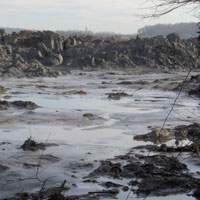
Coal Ash Cleanup Allegedly Deadly for Tennessee Workers
View the page for this story
In 2008, the wall of a pond holding a billion gallons of toxic coal ash slurry from a huge coal power plant owned by the TVA in Kingston, Tennessee suddenly collapsed. The spill contaminated 300 acres of land and required a massive cleanup project. Dozens of cleanup workers involved in have died, and hundreds more have fallen ill. Men’s Journal Senior Editor J.R. Sullivan joined Host Bobby Bascomb to talk about the fight for justice in the courts by the workers and their families. (11:20)
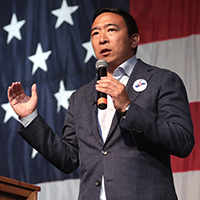
Andrew Yang’s Climate Plan
View the page for this story
Democratic Presidential candidate Andrew Yang is calling for a universal basic income, which he calls a Freedom Dividend. He wants the federal government to send a thousand dollars each month to every US citizen over the age of 18. The 44-year old entrepreneur sat down with Host Bobby Bascomb to discuss how the plan relates to his five-pronged proposal to address the climate emergency, which envisions the U.S. economy achieving net-zero emissions by 2049. (12:46)
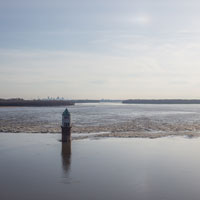
Beyond the Headlines
/ Peter DykstraView the page for this story
In this week’s Beyond the Headlines Peter Dykstra joins Host Bobby Bascomb to take a look at how algal blooms have turned tourist beaches on the Gulf Coast into ghost towns. Then, the two discuss “happy hour” efforts by a Finnish grocery store to reduce food waste. In the history calendar, they travel back to 1900, when the United States’ ban of Cuban weather bulletins had deadly consequences. (04:32)
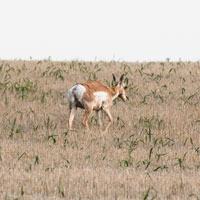
Pronghorn Antelope
/ Mark Seth LenderView the page for this story
Living on Earth’s Explorer in Residence Mark Seth Lender has seen pronghorn antelopes many times, and at his approach they usually turn tail and run. But when a less timid pronghorn antelope stands his ground, an opportunity arises for a closer encounter. (03:46)
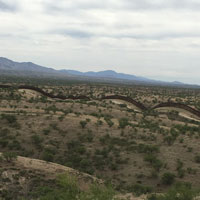
How the Border Wall Could Harm Wildlife
/ Bobby BascombView the page for this story
Amid outcries about its immigration policy, the US government is moving forward with an expansion of the border wall with Mexico. Biologists are raising the alarm that the wall can be a dead-end for migrating animals, including some bird species. Host Bobby Bascomb reports from the border on how construction of the wall can disturb nesting birds and damage sensitive habitat. (13:56)
Show Credits and Funders
Show Transcript
HOSTS: Bobby Bascomb
GUESTS: Jared Sullivan, Andrew Yang
REPORTERS: Peter Dykstra, Mark Seth Lender
[THEME]
BASCOMB: From Public Radio International – this is Living On Earth.
[THEME]
BASCOMB: I’m Bobby Bascomb.
Democratic presidential candidate Andrew Yang says his "Freedom Dividend" would help Americans focus on combating the climate crisis.
YANG: 78% of Americans are living paycheck to paycheck. And then if you come to them and say, "we need to fight climate change", a lot of them look up at you and say, "I can't pay my bills today, I'm not worried about ten years from now." And so if you get the boot off their throats with $1,000 dollars a month, they look up, they feel like their future is assured, their children's future is assured. Then all of a sudden they'll say, "wow, yeah, we really do need to make progress on climate change."
BASCOMB: Also, ecologists say construction of the border wall between the US and Mexico is wreaking havoc on wildlife.
SERRAGLIO: They've completely bladed all the vegetation. It's just this big, dusty, you know, wasteland, now it's like acres of just dust now, whereas before, it was this lush vegetation.
BASCOMB: That and more this week on Living on Earth – Stick Around!
[NEWSBREAK MUSIC: Boards Of Canada “Zoetrope” from “In A Beautiful Place Out In The Country” (Warp Records 2000)]
[THEME]
Coal Ash Cleanup Allegedly Deadly for Tennessee Workers
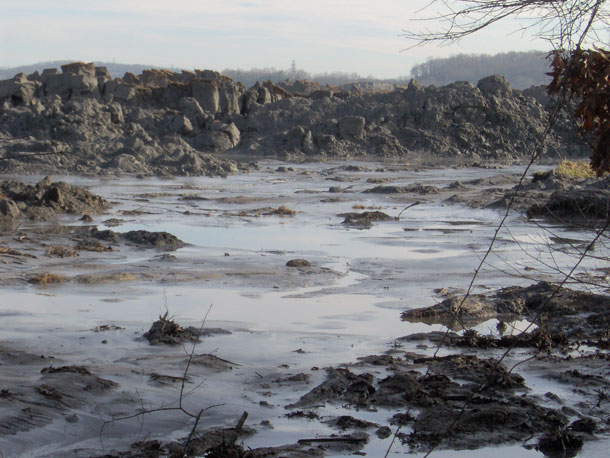
300 acres of land were inundated by toxic coal ash slurry after the Kingston Power Plant Spill. (Photo: Wikimedia Commons, Brian Stansberry, CC)
BASCOMB: From PRI and the Jennifer and Ted Stanley Studios at the University of Massachusetts Boston, this is Living on Earth. I’m Bobby Bascomb, in for Steve Curwood.
In 1955 the biggest coal plant in the world at that time was built near Knoxville, Tennessee and for the next 60 years its coal ash waste piled up in a huge holding pond until it burst in 2008, spilling over a billion gallons of deadly coal ash. Coal ash slurry is a toxic stew of chemicals and it spread across 300 acres of land prompting a massive cleanup project, involving 900 workers. 40 of the people who helped clean up the spill have since died, including Billy Isley. His wife Lena held her husband in her arms as he died coughing up blood. Lena is a registered nurse and she said it just didn’t look right.
ISLEY: It was thick and dark. And that's usually when something is, you know, coagulated and it just it don't look, you know, like normal blood flow. So, I knew, and every time I would try to, you know, clean his mouth out there was like particles in the blood. Little bits of black particles. And I kept thinking to myself, Oh my God I know what this is. And it was the first thing I thought of, it's just stupid coal ash you know? Because every one of these guys, that's what’s what went wrong with them is their lungs have just given out. And, they don't, you know, they can't breathe.
BASCOMB: TVA, the Tennessee Valley Authority, owns the Kingston power plant.
ISLEY: TVA killed my husband, I truly believe that TVA and Jacobs killed my husband. Because all he was out there to do was to work and provide for his family.
BASCOMB: More than 300 additional workers have fallen ill with cancer, heart failure, stroke, and lung disease. They blame their illnesses on the work they did cleaning up the coal ash spill and it has taken years to have their day in court with this corporate agency of the federal government. Jared Sullivan, Senior Editor of Men’s Journal, joins us from New York City for more. Jared, welcome to Living on Earth!
SULLIVAN: Thank you for having me, I appreciate it.
BASCOMB: So, can you briefly explain for us what happened back in 2008 that led to this huge coal sludge spill?
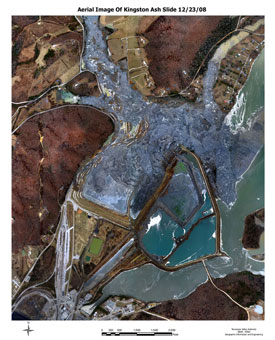
The coal ash byproduct also seeped into local waterways after the Kingston spill, contaminating water. (Photo: Wikimedia Commons, TVA CC)
SULLIVAN: Yeah. So, on December 22, 2008, at a TVA power plant outside of Knoxville, Tennessee, there was a six story, 80 something acre pile of coal ash. And coal ash is the byproduct of burning coal to produce electricity. Well, in the middle of the night, right before Christmas 2008, this big mountain collapsed. And it covered 300 acres, it flowed into two nearby rivers and got everywhere. If you compared the sheer volume of it, it's 100 times larger than the Exxon Valdez oil spill in it being a billion gallons in all of this coal ash that spilled. And TVA, the Tennessee Valley Authority, they own this power plant and kind of from the get go after this spill they told everyone that this this coal ash that was now covering 300 acres was totally safe. It posed no harm to the people that live near it or the people that were helping clean it up. But, jump ahead 10 years where we're at today, and now 40 people who helped clean up this coal ash are dead and 300 and something are ill.
BASCOMB: And, as you said, this is a huge spill, you know, on the scale of the Exxon Valdez, how long did the project take and how many people were involved?
SULLIVAN: So, 900 people were involved. I believe it was a almost a six year project, it was in that ballpark. So it took a long time, you know, 300 acres covered in coal ash and it was a foot deep in spots, six foot deep and others. So, it was a major undertaking.
BASCOMB: And, you write that the Tennessee Valley Authority actually said it was safe to eat. Is that right?
SULLIVAN: Yeah. So, they would have these morning safety meetings during the cleanup process. So, a TVA official would stand up in front of the workers and he would say, basically, don't worry, you could eat a pound of coal ash a day and you'd be totally fine. But, there's TVA documentation that goes back to the 80s that show that coal ash contains arsenic, lead, mercury, like a whole host of really toxic things. It's basically a Long Island Iced Tea of poison, as I put in my piece. But, yet, these officials would stand up and tell these workers regularly that this stuff was so safe. And they were given really no way to even clean themselves off. And, they're given no dust mask, no respirators and basically just are out there working in just jeans and T-shirts and hard hats.
BASCOMB: And you write that possibly part of the reason that they didn't give workers that type of safety equipment was that they didn't want to alert the people in the surrounding area, the people that live there, that there was a problem here.
SULLIVAN: Yeah, it's a great point. So, the community like had a hunch from the beginning that this stuff was hazardous, right? So, they tried to like appease their concerns and not to like further upset them or to worry them, they didn't want the workers to be wearing dust masks or respirators. And the lawyer who my story follows closely, basically found an email that says as much. Like one tells another that this is a public perception operation. Jacobs and TVA were trying to control their image, it was bad PR if the workers were out there cleaning stuff up with hazmat suits, which they should have been. And, Jacobs Engineering is the contractor that TVA hired to kind of oversee the safety and cleanup of this huge spill. But, Jacobs and TVA, they didn't want people seeing workers in that. My reporting suggests that they were trying to obscure the damages of the coal ash.
BASCOMB: And, so, when did they start getting sick? I mean, the initial spill was in 2008. How long did it take for people to start feeling symptoms?
SULLIVAN: So, when the initial spill occurred, a lot of this coal ash was really like mucky, kinda like mud, really. So, it wasn't until the summer of 2010 that a lot of the stuff began to dry. That's when the stuff started to get in the air and they really started to inhale, it was in 2010. And, that's when they really started to get sick. That's when they started to have blackouts in their trucks. That's when they started to have, a lot of them had strokes. A lot of them sort of tasted funny-- they describe it as like chewing on aluminum foil. That's how they talked about the taste of the air at that point. So, that's when a lot of them kind of all at once started to have major health issues.
BASCOMB: So, it was while they were still working on this cleanup job that they were already feeling these effects.
SULLIVAN: Oh, yeah. Oh, yeah yeah yeah.
BASCOMB: And, how did the company respond?
SULLIVAN: So, I believe was in May of 2015, a group of 25 of the workers approached a Jacobs Engineering official and asked for dust masks. And, there are some air monitors on site. And, he told them that TVA had evaluated these air monitors and that their health complaints were not linked to the coal ash and thus they were denied dust masks or respirators or any protective gear. Both companies, TVA and Jacobs, still say that the workers’ health issues are not linked to coal ash, that there's no way that this coal ash could have, could have harmed these people.
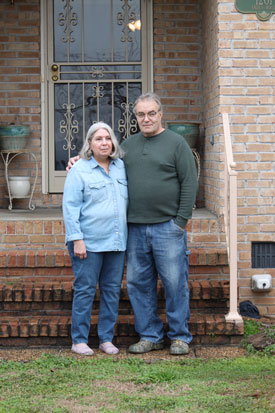
Many workers and their family members fell ill during and after the Kingston spill cleanup project, including Ansol and Janie Clark. (Photo: Courtesy of J.R. Sullivan)
BASCOMB: And, I understand that it's not just the workers themselves that are feeling these effects, but some of their families also. Can you tell me about that?
SULLIVAN: When the workers left each day there was-- they described as like a kitty litter sized container of water that they were supposed to wash their shoes off. But, that's the extent of the cleaning that they went through when they're leaving the work side each day. So, the workers would come home each day caked in mud, their boots caked in mud, their clothes caked in mud, and their kids would come up to them and give them hugs when they got home from work. A lot of these kids now have health issues because of hugging their parents when they came home from work covered in this coal ash. And a lot of workers also describe the havoc the coal ash did to their washing machines. The coal ash was so toxic that it would like literally eat apart their washing machines. One woman I spoke to had to replace her washing machine three times because this stuff just kept on eating the motors and the metal that was inside of it. So, a lot, a lot of spouses who were washing the workers’ clothes also now have issues. There's one in my story, she has had three strokes and she's only 45 years old, and she attributes the strokes to handling her husband's clothes when he'd come home from work.
BASCOMB: Gosh, I mean, if this stuff can eat apart a washing machine, imagine what it's doing to a human body.
SULLIVAN: And, the EPA does not consider coal ash a hazardous material. Really as a direct result of the Kingston spill that my story covers, the EPA began the process to implement new regulations on coal ash and how it must be stored. In 2018, as now, power companies can really just dig a big hole in the earth and dump coal ash straight into it. Without any liner, without treating this ash, just totally raw coal ash straight into the earth. There are 400 of these coal ash dump sites across the US. And, studies have shown that 90% of them leak and contaminate groundwater.
BASCOMB: You know, it just seems, I think, shocking to me, and probably most people listening, that this is how coal ash is disposed of. Surely it flies in the face of the Clean Water Act and, you know, dozens of other environmental rules that are pretty well accepted.
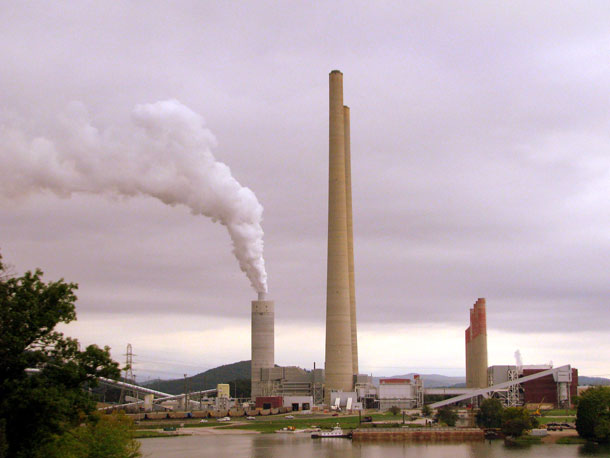
The Kingston coal-powered electric generating plant was the largest such power plant in the nation when it was completed in 1955. (Photo: Flickr, Brent Moore CC BY-NC 2.0)
SULLIVAN: So in 2015, the EPA began the process of regulating coal ash, and at the time the EPA was under the Obama administration; then obviously, the election happened and that really changed things as far as EPA is concerned as far as it regulating coal ash. So in 2017, the EPA began the process of rolling back the regulations that were slated to take effect in 2018. That, as I said, were a direct result of the Kingston spill.
BASCOMB: Now, I understand that there's been a lawsuit since the company is not taking responsibility for these workers. What's happening with that?

J.R. Sullivan is a senior editor with Men’s Journal. (Photo: Courtesy of J.R. Sullivan)
SULLIVAN: Yeah, so in 2012, a small group of the workers approached this lawyer in Knoxville, Tennessee, his name is Jim Scott, basically just complaining that they were not feeling well. They were coughing up blood, that they were just not feeling right. And so this lawyer, Jim Scott started to look into it. And at first, you know, I think like any lawyer, he was naturally kind of skeptical of it. But then he started digging into some past cases and do some research of coal ash and quickly realized that, my goodness, these workers are telling the truth. And, one of the workers in particular, a guy named Mike McCarthy, had secretly recorded on his cell phone a Jacobs employee telling him that if he wore a dust mask to the job site, he would be hanging himself with his own genitalia. So, seeing that secret recorded cell phone video, is what really got the lawyer Jim Scott convinced what these workers were saying were true. So, in the fall of 2018, there was a trial in which the plaintiffs had to convince the jury that the coal ash could have plausibly affected their health. And, the jury ruled in the workers’ favor, which means that now in an upcoming phase two of the trial, which will likely be in 2020, the workers will get to sue for damages relating to their specific illnesses.
BASCOMB: Jared Sullivan is senior editor of Men's Journal. Thank you so much for taking this time with me.
SULLIVAN: Thank you.
BASCOMB: We reached out to TVA and Jacobs Engineering for a response. Scott Brooks from TVA sent an email statement which said, in part, “Our major issue with this Men's Journal article is that it relies on allegations which have not been verified by facts in court. Phase two of the Jacobs litigation would determine whether anyone was actually harmed by work performed at Kingston. That hasn't been determined yet."
Related links:
- Men’s Journal | “A Lawyer, 40 Dead Americans, and a Billion Gallons of Coal Sludge”
- NATIONAL GEOGRAPHIC | "Coal’s Other Dark Side: Toxic ash that can poison water and people"
- Physicians for Social Responsibility - Coal Ash: Hazardous to Human Health
- US Environmental Protection Agency - Coal ash basics
[MUSIC: Noah and The Whale “Instrumental II” from The First Days of Spring, 2009 Mercury Records]
BASCOMB: Coming up, 2020 Presidential Candidate Andrew Yang. That’s just ahead on Living on Earth.
ANNOUNCER: Support for Living on Earth comes from Sailors for the Sea and Oceana. Helping boaters race clean, sail green and protect the seas they love. More information at SailorsfortheSea.org.
[CUTAWAY MUSIC: Bela Fleck & the Flecktones, “Flight Of the Cosmic Hippo (Reprise)” on Flight Of the Cosmic Hippo, Warner Bros]
Andrew Yang’s Climate Plan
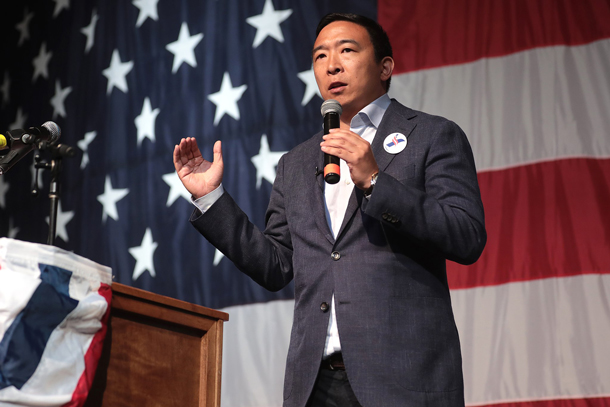
Andrew Yang’s signature proposal is a “Freedom Dividend” of $1000 a month for every US citizen over the age of 18. (Photo: Gage Skidmore, Wikimedia Commons CC BY-SA 2.0)
BASCOMB: It’s Living on Earth, I’m Bobby Bascomb.
Nearly all the Democratic presidential candidates would beat out President Trump in New Hampshire, according to a recent Emerson College poll. In a head to head matchup, 44-year-old entrepreneur Andrew Yang would beat President Trump by 8 points. Only Joe Biden would have a larger margin according to the poll. Mr. Yang is perhaps most well known for his proposal of a universal basic income, which he calls a “Freedom Dividend.” That’s a thousand dollars each month to every American citizen over the age of 18. I asked him to relate that plan with his 5-pronged proposal to address the climate emergency, which envisions the US economy achieving net-zero emissions by 2049. I sat down with Mr. Yang at the New Hampshire Public Radio studios in Concord. Andrew Yang, welcome to Living on Earth!
YANG: Thanks for having me. It's a pleasure to be here.
BASCOMB: So Democratic voters rank climate change as a top concern in the 2020 campaign. If you win the Democratic nomination and are elected President, what policies would you enact to address climate change?
YANG: So the first phase is to try and move towards a renewable economy ourselves as a source of energy. One big component of this is to me a carbon fee and dividend that helps internalize the cost of carbon emissions on to producers and companies. Because right now, when they pollute, there's no accounting for all of the harm that's being done to us all, collectively. The second pillar is moving towards a sustainable world. And this is the difficult truth: that the United States is only 15% of global emissions. So even if we were to curb our own emissions dramatically, climate would continue to warm. So the question is, how can we move the other 85% of global emissions in the right direction? And what's happening right now is that China is going to Africa and saying, "Hey, I've got a power plant for you. It burns coal." And then Africa says, "Great!", because their interest is just trying to get cheap sources of energy by any means necessary. So to curb that set of emissions, we're going to have to go to developing countries and say, "Look, don't use the coal power plant, use these wind turbines or solar panels, and we're going to make them cost effective for you." The third thing is to move ourselves and our people to higher ground. So my flagship proposal is putting $1,000 a month into every American adult's hands, which will make us all more able to adjust and adapt. But we need to have public resources in place so that communities that are experiencing climate change can realistically address and mitigate those effects. And so the fourth part is to try and reverse some of the damage that's being done. So that includes reforestation, that includes seeding the oceans, that includes investing in research to try and find more renewable forms of energy, but also ways that we can actually undo some of the damage that we're doing. And then the last part is the shortest, but maybe the most important: we should have a constitutional amendment that says it is the government's responsibility to safeguard, protect and preserve the environment for generations to come.
BASCOMB: Now, perhaps the policy proposal that you're most well known for is the Freedom Dividend. And that's a universal basic income that would give every American citizen over 18 years old $1,000 per month. But generally speaking, more money for consumers means more consumption. And while that may be good for the economy, it's not usually good for the environment. How do you respond to that?
YANG: A couple things. One impediment to making progress on climate change is that 78% of Americans are living paycheck to paycheck, and almost half can't afford an unexpected $400 bill. And if you come to them and say "we need to fight climate change", a lot of them look up at you and say, "I can't pay my bills today. I'm not worried about 10 years from now". And so if you get the boot off their throats with $1,000 a month they look up, they feel like their future's assured, their children's future's assured, then all of a sudden, they'll say, "Wow, yeah, we really do need to make progress on climate change". We can actually speed up addressing climate change by lifting this mindset of scarcity that right now has swept our communities. In many cases, there are many people that, I think, if you had $1,000 a month, might actually adopt a more minimalist style of life. You can imagine four people getting together and saying, "hey, among the four of us, that's $4,000 a month. Why don't we just get a small home, and then, you know, live there, and then you'll work on your screenplay, like, you know, like, I'll commute and work as I'm doing now, like, someone else will be a caregiver." There is a world where the carbon footprint of a group of people might actually not go up if you have these resources that are, frankly, more flexible and dynamic. You know, they put you in a position to make more human choices. And the example I use in my own family is that my wife is at home with our two young boys right now, one of whom is autistic. And her work right now is considered to have zero value in the economy and GDP and the marketplace. But we know it's the most important work that anyone does. The goal would be to expand our notions of what work is. And I think a lot of the work that we would like to be doing will actually be very positive for the environment.
BASCOMB: Part of the universal basic income is to supplement the incomes of people whose jobs are going away because of automation. But also there are, I mean, industries like coal miners, you know, which are middle class people in these swing states like Ohio; to what degree do you think that this Freedom Dividend would benefit those types of workers?
YANG: Well, it would be a tremendous step forward for many Americans, because $1,000 a month goes very far in a lot of the country. And the truth is that when some of these jobs are being lost, we're selling that we're going to retrain American workers for the new jobs. But the numbers show that almost half of the manufacturing workers who lost their jobs never worked again. And that was with government retraining. Government retraining is largely ineffective in many environments. Independent studies have shown its effectiveness rate to be between zero and 15% in some of these environments. So we have to be more direct and honest about providing more American workers a path forward in a way that they'll actually be able to make use of.
BASCOMB: Yeah, I mean, we hear "Oh, we'll just retrain coal miners to make solar panels instead." But it's not that easy.
YANG: It's really not that easy. We're not infinitely adaptable. We're not widgets, like, imagining that middle-aged men and women are just going to go up and be like, "All right, now I'm a this; now I'm a that", like, that's just not the way humanity works. We have to be more honest. The biggest mistake we're making is that we're equating economic value and human value. And we're saying that if your job is no longer relevant, then you're worthless, and we have to find something new for you to do or you will continue to be worthless. And that's a very erroneous approach to these problems. We have to reverse it and say, Look, we're all human beings, we have intrinsic value. What good is record high GDP if the economy is not working for us? Instead of treating us all as economic inputs into this giant capital efficiency machine, we should be asking ourselves, how is this economy designed to optimize our well being? And that includes sustainability and a climate that is healthy and strong for us and our kids.
BASCOMB: You've also proposed some geoengineering techniques, technologies. Can you talk a bit about that -- what, and why?
YANG: So geoengineering is a big scary word. It sounds awfully daunting. But even if you do something like planting lots of trees, that's technically geoengineering. And I think everyone would be excited about that, because trees capture carbon and bring it out of the atmosphere. So what else could geoengineering look like? It could look like re-seeding oceans; it could look like trying to make clouds more reflective, so that some more of the sunlight doesn't end up heating up the oceans or land. If you look around the world, you have several island countries that are literally getting lost to the ocean and are submerging. Now, these countries are not in a position where they could legitimately geoengineer, because they don't have the resources. But if you were a country that was a world power, that did feel like it was in your interest to do so, you might take matters into your own hands. And I'm thinking of China, specifically, because China has massive climate change related problems. And they're not very consultative. You can imagine them spraying sulfur dioxide into the atmosphere above their own country and just shrugging, and not telling anyone else they were doing it. So the question is, how do we avoid that scenario from unfolding 25 years from now? And to me, the answer is to exert American leadership and say, Look, let's get together the world's researchers and scientists who are looking at different geoengineering measures, and see what people are finding out, to see what we're learning, see what's on the table, and try and achieve some kind of global consensus and structure rather than having individual actors go off on their own.
BASCOMB: But all of these things that we've been talking about cost money. Your plan sounds expensive; where do you think the money for it would come from?
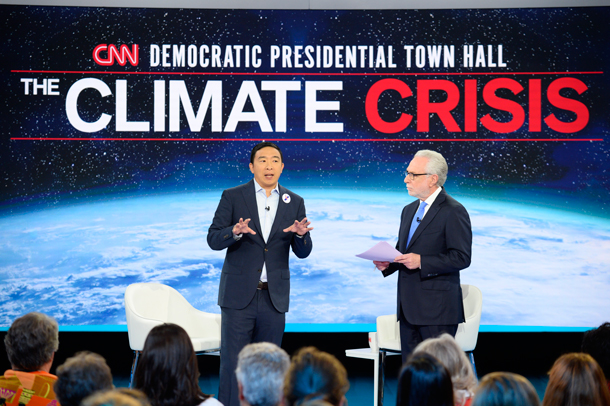
Andrew Yang laid out his plan to address climate change at the 7-hour CNN Climate Crisis Town Hall on September 4, 2019. (Photo: CNN)
YANG: Well, the first big thing, and I think most people listening to this would agree, is that the real expense is going to come if we do nothing. We're talking about trillions and trillions of dollars in lost commerce and devastation, but also human life. The other thing is that over our history, we subsidized fossil fuel companies to the tune of hundreds of billions of dollars, and now they act like anything we do in this other direction is going to, quote unquote, hurt the economy. It's ridiculous. We have to do away with this supposed tug of war between doing right by the environment, and growing the economy and creating jobs. We have to redefine the way we see economic progress. We have to start accounting for the fact that record high GDPs are meaningless if your GDP goes up every time there's a hurricane, because, you know, I mean, like a hurricane actually means you have to rebuild a bunch of stuff. So it's like oh, GDP went up, for like the worst possible reason. So we have to redefine our economic measurements to actually correspond to true progress. And one of my goals as president would be to change GDP to be a more complete measurement, that included things like children's health and wellbeing, mental health and freedom from substance abuse, clean air and clean water -- things that would actually correspond, in many cases, to a sustainable planet. And if this sounds difficult to you, keep in mind that we made up GDP almost 100 years ago. And even the inventor of GDP at the time said this is a terrible measurement for national wellbeing and we should never use it as that. So it's 100 years later, we need a new measurement that includes our environmental sustainability. And that way we can do away with this destructive tug of war that we either choose the economy or a sustainable future.
BASCOMB: Now I've read that your favorite president is Theodore Roosevelt, who was an outdoor enthusiast, and a huge conservationist. I mean, he set aside more than 200 million acres of public land. But why was he your favorite president?
YANG: Well, that was part of it. I mean, we all owe him some of our national parks and some of the greatest national treasures. But I like the fact that Teddy was very solutions oriented and bipartisan, and wasn't afraid to go against the grain in terms of powerful interests of his time. He was a trust buster. And I think that there are some parallels to what's needed now. His "Man in the Arena" speech spoke to me when I was young and first read it. There's also this thing, and this is going to be a little bit, you know, sound like a movie character or something. But there was one time he got shot during a speech and then finished the speech. Like -- [LAUGHS] and so you know, like, some of these impressions, to me, made him seem like the archetype of the kind of President we would need in a time of trouble.
BASCOMB: Mmm, sort of larger than life; I mean, if you can finish a speech with a bullet in your body! ... [LAUGHS]
YANG: Yeah, he got shot in the shoulder, and then was like, "I'm gonna finish this." Afterwards, he got taken for treatment. No promises I would do the same, I'm sure if I got shot, I'd be like "hospital now, please".
BASCOMB: Yeah, yeah [LAUGHS], anybody would. On your website, you discuss the need to protect American public lands. I wonder if you'd like to share a couple of your favorite places to go -- you know, public lands, national parks or anything like that?
YANG: So I went to Yosemite with my brother for his bachelor party hike. So as you can tell, we're pretty boring, like, if that's the bachelor party celebration --
BASCOMB: Sounds good to me! [LAUGHS]
YANG: [LAUGHS] Yeah, sounds good to me, I mean it was great! And it was so breathtaking; you almost couldn't believe what you were seeing. It was something that you have to experience to, to understand. So I think Yosemite as a national treasure is amazing. And then in upstate New York, there's a set of mountains there called the Shawangunks, the Gunks; I've done some climbing and hiking there. And in both of those environments, you almost can't believe it, it's like, it's like it was designed for you to hike. [LAUGHS] How else to put it? Like, it's almost too good to be true. It's like, it's almost as if someone deliberately tried to make this terrain ideal for a hike, this is what they would do.
BASCOMB: Andrew Yang is an entrepreneur and Democratic candidate for the 2020 presidential election. Andrew Yang, thank you so much for taking this time with me.
YANG: Thank you for having me. It's been a joy sitting down with you.
Related links:
- Andrew Yang campaign’s climate change plan
- InsideClimate News | “Andrew Yang on Climate Change: Where the Candidate Stands”
- Living on Earth’s coverage of CNN’s Climate Crisis Town Hall
[MUSIC: Chet Baker, “But Not For Me” on Dinner Is Served, by George and Ira Gershwin, Sony Music Entertainment]
Beyond the Headlines
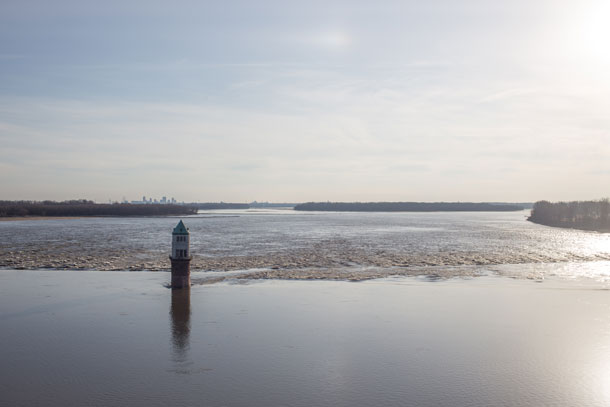
Beaches along the Mississippi Gulf have been affected by high levels of cyanobacteria, often called blue green algae, which can be toxic to beachgoers. (Photo: Paul Sableman, Flickr, CC By 2.0)
BASCOMB: It's time for a trip now beyond the headlines with Peter Dykstra. Peter is and editor with environmental health news. That's EHN.org and DailyClimate.org. Hey there, Peter, what do you have for us this week?
DYKSTRA: Hi, Bobby. We've got some good news and bad news. And let's get the bad news out of the way. Even the bad news has a little bit of good news. Because there's one place right now where you can take a nice, lonely walk on the beach in a place that's usually crowded with tourists.
BASCOMB: Okay, where's that?
DYKSTRA: That'd be the Mississippi Gulf Coast. And the reason it's been empty pretty much since the Fourth of July the whole tourist season is that there's a huge bloom of cyanobacteria, blue green algae, that's hit the Gulf Coast.
BASCOMB: Why is it so bad there this year?
DYKSTRA: Because of the rain in the upper Midwest, that washe huge amounts of water and creates floods up there. The floods carry farm fertilizers in huge amounts, they get offshore, they create the dead zone that we've all heard about in the Gulf. And right now there's a blue green algae bloom off the Mississippi beaches. Casino towns like Biloxi, and quaint little beach towns, like Waveland, are taking a hit with the tourist trade down as much as 70% since the Fourth of July.
BASCOMB: Wow, yeah, this must be an important time of year for them for you know that tourist revenue.
DYKSTRA: It is, they depend on it. And of course, this would be the third thing in the last two decades. That's completely knocked the tourism industry down in 2005. Of course, it was Katrina, that utterly destroyed a pretty little town like Waveland. And in 2010, we had the Deepwater Horizon oil spill in the spring, just before tourist season. They've gotten knocked down, they've got back up again. And here comes a third wave that's really hit Mississippi tourism hard.
BASCOMB: All right. Well, I think you promised us some good news too? What do you have?
DYKSTRA: Oh, sure. The good news is a neat idea. And it involves happy hour. And who does that like happy hour?
BASCOMB: Indeed, who doesn't?
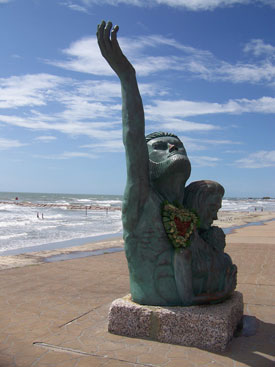
Memorial of the tragic Galveston Hurricane of 1900. (Photo: Sarah Page, Flickr, CC By 2.0)
DYKSTRA: In Finland, there's a grocery chain called S-Market. They have over 900 stores, some big ones, some small ones. And at nine o'clock every night, there's a happy hour of sorts, where they sell meat and fish that are getting near their expiration date.
BASCOMB: So happy hour, you could actually meet someone over meat, is that the idea here?
DYKSTRA: Meet someone over meat, get a date, near the expiration date. And that's important because not only can folks get a bargain on food that's still edible, but there's over 1.3 billion tons of food wasted in the world each year, according to the UN. And if we liquidate that meat and fish rather than toss it out, it's a beginning to saving some of that huge amount of waste. The UN also says that fully one third of the food the world grows ends up getting wasted. That's a waste of money. It's a waste of labor. It's a waste of fossil fuels to run the farm equipment. It's a waste of water. It's an unseen tragedy that we can do better than, and this is one little idea that could help.
BASCOMB: Hey, well, let's see if it catches on. What do you have for us from the history vaults this week?
DYKSTRA: With all of the uproar lately about politicizing the hurricane map, let's look back to some really tragic politicizing. September 8, 1900, hurricane forecasting was vague enough, it was mostly guesswork. But the US had gotten a warning from Cuba's weather service that a big storm might be headed toward Texas. The only problem with that is that the US Weather Bureau hated the Cuban weather service. And the boss of the US Weather Bureau banned all use of Cuban weather bulletins. And what happened is that 7,000 people died when the great hurricane of 1900 hit the city of Galveston with high winds and flooding storm surge.
BASCOMB: Man so you can have your beef with whoever but nature always bats last.
DYKSTRA: Yeah, whether it's climate change, or floods or anything else. Nature doesn't have any politics. And it's a good reason to respect what we hear from scientists, whatever problems you have with the country that science comes from.
BASCOMB: Yeah, exactly. All right, Peter. Well, thanks was nice chatting with you. Peter Dykstra is an editor with Environmental Health News. That's EHN.org and DailyClimate.org. We'll talk to you again real soon.
DYKSTRA: Thank you, Bobby, and we'll talk to you soon.
BASCOMB: And there's more on the stories on our website loe.org.
Related links:
- HuffPost | “Mississippi Beaches Have Been Vacant for Two Months as a Toxic Algae Bloom Lurks Offshore”
- Awesome Stories | “Galveston and the Great Storm of 1900”
- The New York Times | “The World Wastes Tons of Food. A Grocery ‘Happy Hour’ is One Answer.”
[MUSIC: Nina Simone, “My Baby Just Cares For Me” on Dinner Is Served, by Walter Donaldson and Gus Kahn, Sony Music Entertainment.]
BASCOMB: Coming up, The US border wall with Mexico can be a dead end for migrating mammals and even a hazard for some birds. That’s just ahead on Living on Earth.
ANNOUNCER: Funding for Living on Earth comes from you, our listeners, and United Technologies, combining passion for science with engineering to create solutions designed for sustainability in aerospace, building industries, and food refrigeration. UTC companies such as Otis, Carrier, Pratt and Whitney, and UTC Aerospace systems are helping to move the world forward. You can learn more about United Technologies by tuning into the Race to Nine Billion podcast; listen at racetoninebillion.com. This is PRI, Public Radio International.
[CUTAWAY MUSIC: Nina Simone, “My Baby Just Cares For Me” on Dinner Is Served, by Walter Donaldson and Gus Kahn, Sony Music Entertainment]
Pronghorn Antelope
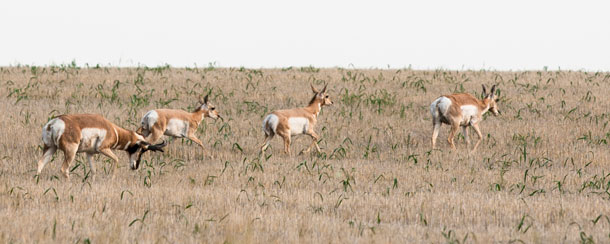
In Grasslands National Park, Saskatchewan, this huge pronghorn buck lowers his head, shooing the herd along. (Photo: Mark Seth Lender)
BASCOMB: It’s Living on Earth, I’m Bobby Bascomb.
In the southern part of their range pronghorn antelope are slight of build, very fast, and intolerant of humans. You may see them mostly on the run. But further north, they are much bigger, a response to the cold climate. As Living on Earth Explorer in Residence Mark Seth Lender tells it, northern pronghorn expect you, not them, to do the running!
Pronghorn Antelope
© 2018 Mark Seth Lender
All Rights Reserved
Heading west, the highway cuts New Mexico in two. Left, the otherworldly telescopes of the very large array listening to outer space, the great disks still, as if in meditation. While, right here on earth a herd of pronghorn antelope roam and graze; come anywhere halfway close to them they raise dust, right up to the stratosphere.
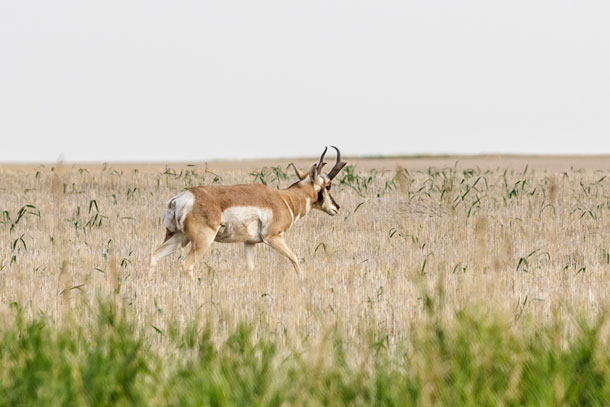
Pronghorns can be found as far north as Saskatchewan and as far south as Mexico. (Photo: Mark Seth Lender)
Antelope.
Odd name for them. They look like stunted deer, deer whose antlers never did grow.
Head north and cross into Saskatchewan, the story progresses differently.
Often in the morning there would be mule deer, three and four with eight point racks, the mist still on the fields all rolling plains of yellow flowers and dawn no more than a gray suggestion on the sky. Prairie dogs and hawks, of course. Coyotes sometimes, distant, and rightly fearful. Even the mule deer took one look and ran.
Pronghorn were the last thing I expected -
But here they were. In good light now. Just across the section fence on the other side of the road.
I pulled the truck off onto the dirt and slowly lowered the window on the driver’s side, which, south of here, the pronghorn I was used to? They would have been long gone.
But no. The lead buck has that look on his face. Watchful. But not in an obvious way. He holds my gaze just a little longer than he would if he were nervous and not so long as if he were warning me away. It’s “Yup, I see you there.” And keeps himself between me and the females he has sequestered to himself. And lets them graze. And stays while the herd drifts further and further away. And lowers his head ever so slightly.
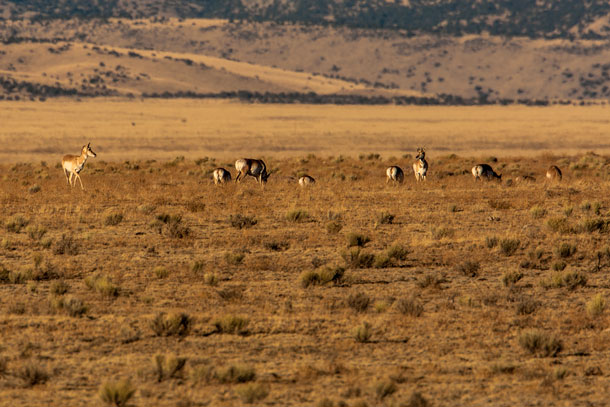
Skittish and slight of frame, Southern Pronghorn say, "Keep your distance; or we run away." (Photo: Mark Seth Lender)
He does not come towards me. Not a matter of deference. Only, the limit of his threat, set by me doing the same and not coming towards him. Broad-in-the-shoulders, the muscles of his chest bulging (like in his free time he’s doing deadlifts), his height, and the way the horns progress thick at the base then narrowing to a point. And plenty long enough. And those hooves. He has a hundred pounds on his southern cousins, more than that on me. He just stands there. Like a tree.
He belongs.
And I? I am only passing through.
BASCOMB: That’s Living on Earth’s Explorer in Residence, Mark Seth Lender.
Related links:
- Visit Mark Seth Lender’s website
- Learn more about the pronghorn antelope
- Special thanks to Destination: Wildlife
- Mark Seth Lender's Field Note on this essay
[MUSIC: Samite, “Resilience” on Resilience, Samite Music]
How the Border Wall Could Harm Wildlife
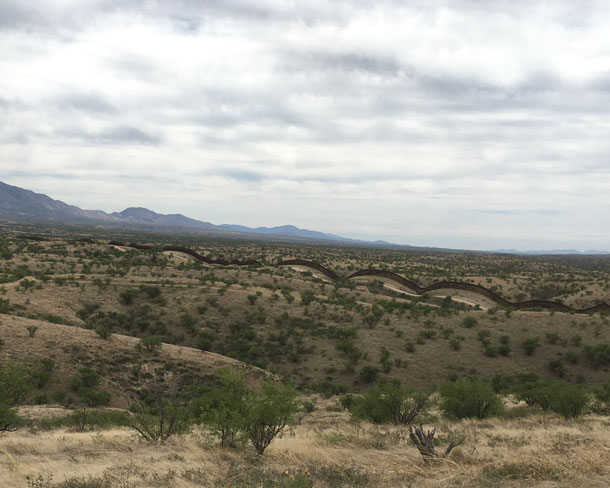
The border wall between the US and Mexico follows the hills and valleys of the rugged arid landscape (Photo: Bobby Bascomb)
BASCOMB: The US border with Mexico spans more than 1900 miles from the Pacific Ocean off the coast of California to the Gulf of Mexico in coastal Texas. Over a third of the border, nearly 700 miles, currently has some sort of barrier or wall and amid the controversy over immigration the Trump administration has pledged to fill in the rest. I went to the border region to see what that might mean for wildlife in the area.
[WIND SOUNDS]
BASCOMB: I’m standing on a hill at the base of the Patagonia Mountains, about 60 miles south of Tucson, Arizona. Thorny cactus with pink and yellow flowers dot the arid landscape. From this elevation it’s easy to see how the border wall perfectly mirrors the topography of the land, rising and falling with these hills and valleys. Except for a small break at a river, the wall extends as far as the eye can see to the West, some 40 miles to Nogales. But to the east it’s a different story.
SERRAGLIO: Up here on the hill we can look East here and see the point at which the border wall ends out there, it doesn't actually go up and over this really rugged terrain that crosses the border right here.
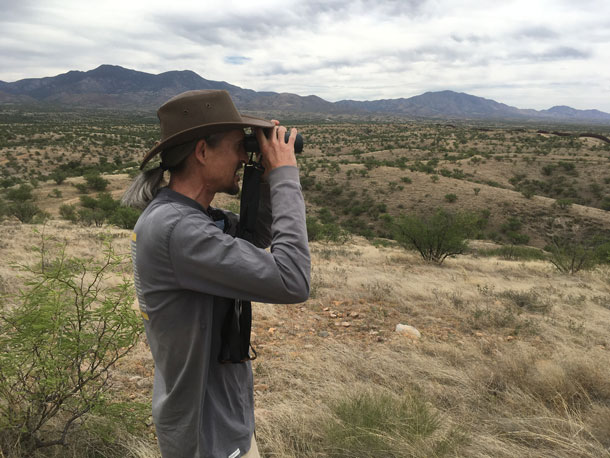
Randy Serraglio from Center for Biological Diversity, looks across the landscape towards the US Mexico border wall. (Photo: Bobby Bascomb)
BASCOMB: Randy Serraglio is the Southwest Conservation Advocate with the Center for Biological Diversity. He’s tall and thin with gray hair pulled back under a cowboy hat and binoculars, at the ready, hanging from a strap around his neck. He says this break in the border wall is a lifeline for migrating animals, including jaguar.
SERRAGLIO: This is one of the handful of really prime Jaguar movement corridors, places where jaguars can move back and forth across the border.
BASCOMB: Historically jaguars ranged from Brazil's Amazon rainforest through Central America and as far north as the Grand Canyon. Starting in the 1960s hunting claimed some 18,000 per year in the US and today only a handful of juvenile males are known to live north of the border including el Jefe or the boss, so named by local school kids. Randy points across the wall to the Mexico side of the border.
SERRAGLIO: He was born there and emancipated and came up here as a relatively young and vulnerable male Jaguar at the age of maybe two or three.
BASCOMB: Using camera traps, biologist were able to keep tabs on El Jefe for several years as he grew into a healthy adult while living in the nearby Santa Rita mountains. Then he abruptly disappeared.
SERRAGLIO: And biologists believe the most likely explanation, he came right back through here and went right back to wherever the females are, and then when he got to his breeding prime around the age of seven, he went back to wherever those females are. And that is critically important for jaguars, they have to be able to do that in order to survive, they have to be able to roam long distances and find territories of their own, and yet still remain connected to that core population. And that's why a place like this is absolutely essential for Jaguar recovery.
BASCOMB: The borderlands in general are home to a huge variety of animals including pronghorn, javelinas, ocelot, mountain lions, bobcats, Mexican Gray Wolf, black bears, and bison to name a few. Dozens of endangered and threatened animal species use these rugged, barrier free, mountains as a highway for migrating between the US and Mexico.
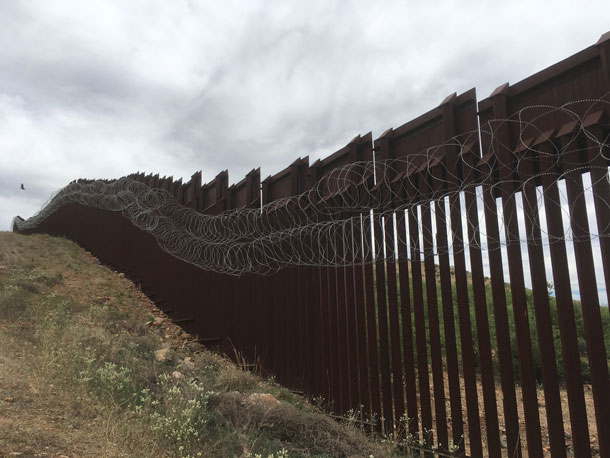
The US border wall is strung with razor wire on the US side of the wall. (Photo: Bobby Bascomb)
SERRAGLIO: There's a herd of bison in the boot heel of New Mexico. And their favorite foraging grounds is on one side of the border and their favorite watering holes on the other. So they often cross back and forth on a daily basis. But if there's a border wall built there, they won't be able to do that anymore. At a certain point, you fragment the landscape enough and you fragment habitat enough and you isolate populations, and they start winking out. That's how species go extinct. I mean, we just know that for a fact.
[SFX DOOR CLOSING CAR DRIVING SOUND]
BASCOMB: Randy and I pile into his pickup truck and drive a few miles down a dirt road to another type wildlife corridor. A lush green band of walnuts, willows, and cottonwood trees hint at the water that lies just below the surface.
SERRAGLIO: These are trees that rely on water, they have to have shallow groundwater in order to survive. So they only grow in these narrow stretches right along the river.
[GETTING OUT OF THE CAR SOUNDS]
BASCOMB: In the monsoon season this river bed would be full of rain water. But it’s the dry season so we stand in the middle of the dusty riverbed to have a look around. Randy lifts his binoculars and points out a small brown and yellow bird.
[BIRD CALL]
SERRAGLIO: Oh, there’s a cute little fly catcher. Oh, yeah. They have a crest in their head. And so they'll perch out in the open like that. And then they'll fly out and catch bugs on the wing and then go back to the same perch again.
BASCOMB: Hence the name flycatcher.
SERRAGLIO: Yeah, they're very acrobatic, they're fun to watch.
BASCOMB: What are those two there?
SERRAGLIO: Those two were kestrels, and one of them had a lizard in its mouth. And the other one was chasing it. There, they just landed up in the tree.
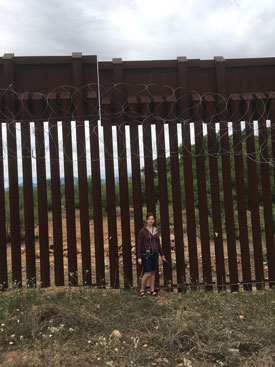
Living on Earth’s Bobby Bascomb at the border wall in Arizona. (Photo: Bobby Bascomb)
BASCOMB: Oh, like the other one is trying to get its dinner.
[BIRD SOUNDS]
SERRAGLIO: Yeah, that's why they were kind of whining. Like, give me that. It could be that that the one was a young fledgling flying around after mom or dad saying feed me feed me. And they're at the point where like, now you gotta start feeding yourself. Get a job.
BASCOMB: Tough Love. Yeah.
[HAWK SOUNDS]
SERRAGLIO: That's the high plaintive call of a gray Hawk, which is a beautiful Hawk that lives in these riparian areas and nowhere else. So it's probably in that big giant cottonwood tree over there. Might even might even have a nest, which would kind of be a disaster.
BASCOMB: A disaster because this riparian habitat teeming with life is also a construction zone. It’s Sunday, so the bulldozers and cranes are sitting idle but Border Patrol is hard at work 6 days a week building a box culvert, a kind of small bridge, across this river. And Randy says all the noise, lights, and cleared land is devastating for wildlife.
SERRAGLIO: See that bank of high intensity lights over there. Yeah, with the shiny covers and everything. I mean, that is completely disorienting for bats and migratory birds and insects at night. You've got these big dump trucks and cranes, and, you know, concrete mixers, and all this other stuff going on here. And they've completely bladed all the vegetation. It's just this big, dusty, you know, wasteland, now it's like acres of just dust now, whereas before, it was this lush vegetation.
BASCOMB: Indeed, nearly all the birds we’ve seen are on the Mexican side of the border which is lush and green with huge trees and a blanket of grass at the bottom of the riverbed. The US side is a dirt road, a pile of gravel, and heavy equipment.
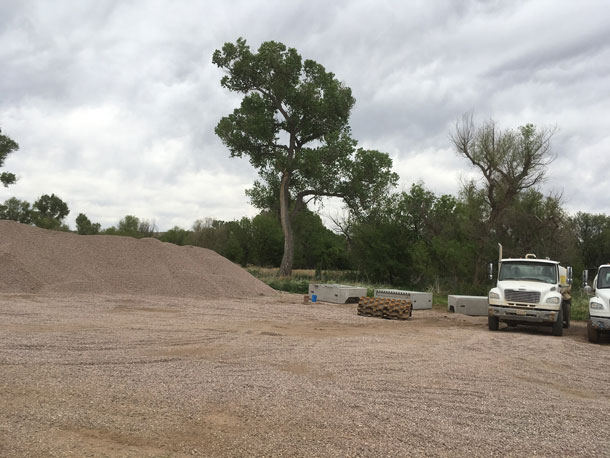
The border wall needs constant maintenance and frequent upgrades. Those construction projects can be disturbing for wildlife in the area. (Photo: Bobby Bascomb)
[WALKING SOUND]
BASCOMB: We can easily see into Mexico from here because instead of 18 foot tall steel slats, which is much of the wall, the border here is simply a car barrier, waist high pieces of metal sticking out at 45 degree angles from the ground.
SERRAGLIO: When we have our summer monsoon, we have these big thunderstorms and the floods would knock this border wall down if they built it right through there. So instead, what we have here, vehicle barriers that are actually in the floodplain, in the riverbed, and they're this old school, Normandy style, cross hatch, you know, steal things, and they stopped cars from driving through, but you know, people could climb right over.
BASCOMB: And so can wildlife. It’s relatively short with large gaps, which allow water to flow through as well as migrating animals.
SERRAGLIO: So vehicle barriers are much more wildlife friendly. And there's still a road that gets bladed, you know, when they have vehicle barriers, but they're not the kind of, you know, absolute obstruction that the border wall creates.
BASCOMB: Customs and Border Protection recently received 2.5 billion dollars for barrier replacements, which includes repairing damaged walls but it also means “improving” the wall from these vehicle barriers, permeable for wildlife, to the full border wall, steel slats up to 30 feet high and a complete dead end for animals.
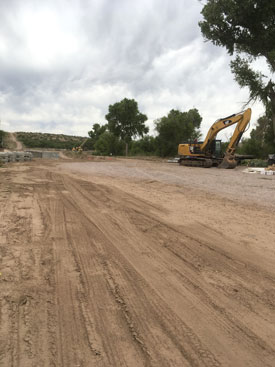
This section of the US side of the border wall is a construction zone to build a small bridge across a floodplain. Ecologists say the heavy machinery and disturbance to the land is detrimental for local wildlife. (Photo: Bobby Bascomb)
SERRAGLIO: They call it replacement barriers, and they're trying to pretend it's not a big deal. But it's a huge difference in the disruption that's caused between, you know, a border wall and a vehicle barrier in terms of wildlife.
BASCOMB: And it’s not just large mammals that can’t get around the wall. Even some birds, including the cactus pygmy owl, will have a hard time getting over a higher wall.
SERRAGLIO: The border wall would be a blockage for this animal because they rarely perch any higher than about 10 feet off the ground. And in some places, this bollard construction is going to be 30 feet tall. And so it will block migration of the cactus pygmy owl. And again, this is a species that exists on both sides of the wall, we have a small population remaining in the US, and there's also a small population in Sonora, and for those populations to be split, just makes it more likely that either or both of those populations will wink out. I mean, again, that's how species go extinct. You know, they become fragmented and smaller and smaller to the point where they're no longer viable.
BASCOMB: So the wall will be impassable for some wildlife but Randy says, not necessarily so for the people it’s supposed to stop.
SERRAGLIO: There was a school group down here looking at the border a few years ago, and these two high school girls, they're like 16, 17 years old, they climb to the top of the border wall, free climbing in about 17 seconds. I mean, you know, it's not gonna really slow people down very much.
BASCOMB: The top of the wall was recently strung with spools of sharp razor wire, on the US side.
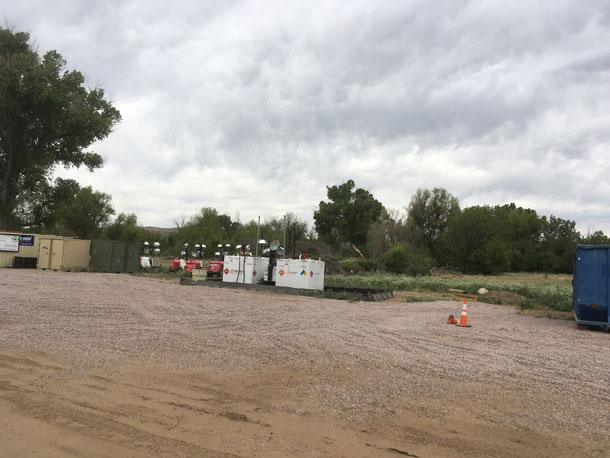
Construction on the US side of the border can be disturbing for wildlife. (Photo: Bobby Bascomb)
SERRAGLIO: They could put it on the other side, because actually, there's another 10 feet there of US property. It's on this side so people can see it. It's for show, this is for people to see to make it look like the military is doing something and be afraid. And it's this Mexican invasion, and oh, my God, we all have to be so scared and spend billions of dollars on this ridiculous monstrosity, you know?
BASCOMB: So if you are somebody trying to get over this wall it would make a heck of a lot more sense to put the razor wire on the wall on the side that you're scaling, not the side that you're jumping off from. Because I mean, if you really wanted to, you could, you could jump out over this and land right here.
SERRAGLIO: Yeah, you could you probably a little banged up. But you could do that easily, relatively easily. You might sprain your ankle, and a lot of people do. But you know, it's a it's just the whole thing is just for show.
BASCOMB: That sentiment is echoed by Congressman Raul Grijalva, who represents Arizona’s 3rd District, including a 300 mile long stretch along the US Mexico border.
GRIJALVA: The effect is going to be minimal, in terms of unauthorized people coming or going. The wall is not the deterrent that Trump wants it to be.
BASCOMB: Mr. Grijalva is chair of the House Natural Resources Committee. Nearly 60 percent of his state is public land and because of that, Mr. Grijalva says Arizona has been targeted for more border wall construction.
GRIJALVA: I think he put Arizona's public lands at crosshairs. And the reason the public lands are so susceptible, is because they're public. They don't get hung up like they are in Texas or the issue of eminent domain and takings.
BASCOMB: Mr. Grijalva says those large tracks of public lands are often critical habitat for wildlife and a source of revenue for Arizona. And a border wall puts both in jeopardy.
GRIJALVA: It's going to rip through two wildlife refuges, wilderness areas, a very fragile desert river and two units of the National Park Service Organ Pipe, and the Coronado National Memorial, both those brought in about 260,000 people and about 30 million to these local economies in terms of revenue and tax, and spending in the area. So one has to wonder what is the purpose? It's been part of a campaign strategy that everybody in the Borderlands is going to have to pay for, and suspending and waving laws is a dangerous precedent for the rest of the country.
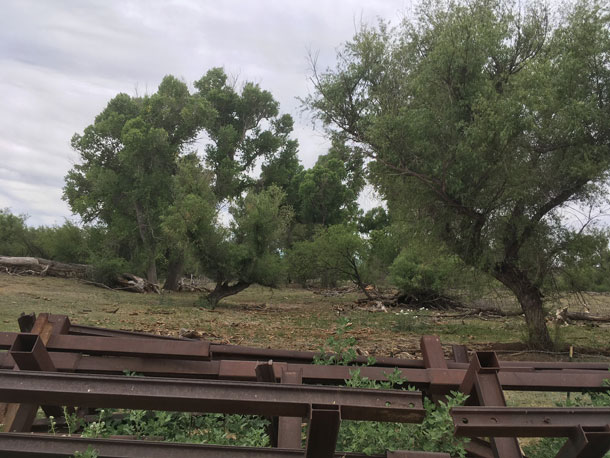
The Mexico side of the border wall is lush and green, habitat for numerous species of birds, mammals, and reptiles. (Photo: Bobby Bascomb)
BASCOMB: The Trump administration invoked the REAL ID act of 2005 to suspend dozens of environmental laws in the borderlands including the Endangered Species Act, the National Environmental Policy Act and the Clean Water Act. Under normal circumstances, those laws could be grounds to sue the government and suspend construction projects. But the dozens of laws routinely cited to protect the environment and wildlife do not apply in the borderlands.
GRIJALVA: And that's what I think bothers us the most than anything else, the rationale for it doesn't fit the price tag cannot justify the kinds of violation, suspending of laws and more importantly, the long term harm that it does to the environment.
BASCOMB: Paul Enriquez is the acquisition, real estate, and environmental director in the border wall program management office for the US Border Patrol. He says it’s necessary to waive those environmental laws so the Border Patrol can meet their deadlines for wall construction.
ENRIQUEZ: Getting the barrier up and making sure that the Border Patrol has resources, the tools they need to secure the border is what's the priority and why the expeditious construction is needed.
BASCOMB: But Paul says they still do what they can to work within the existing environmental laws even though they are not required to do so.
ENRIQUEZ: The goal is not to just disregard the environmental laws that are waived, the goal is to ensure where we're following the intent as closely as possible of those laws, working with the resource agencies that generally have the responsibility for executing those laws, like Fish and Wildlife Service.
[DRIVING SOUNDS]
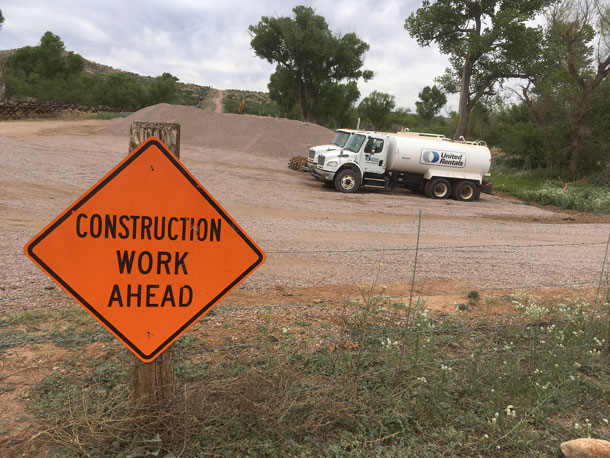
Sections of the US side of the border wall are construction zones, full of heavy machinery and equipment that disturbs animals in the area. (Photo: Bobby Bascomb)
BASCOMB: Back at the border Randy Seraglio stops his truck at a scenic vista near the Coronado National Monument and looks across the rugged hills towards Mexico.
SERRAGLIO: Now you're looking at the world the way a Jaguar sees it. He stands up here and he sees that mountain range over there. And he says, Yeah, I could get there tonight. And see that one over there farther away. I could be there by tomorrow night.
BASCOMB: But, of course, only if there’s not a wall blocking the way. The Customs and Border Patrol recently received 1.375 billion dollars for new wall construction in the Borderlands, including right here in the Coronado National Memorial.
[MUSIC: Glen Velez, “Pan Eros” on Pan Eros, CMP Records]
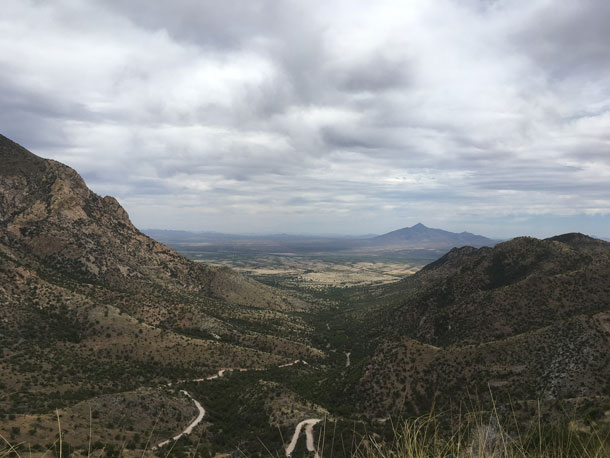
Southern Arizona, the way a jaguar sees it. The rocky landscape is a critical migratory corridor for animals in the Southwest. (Photo: Bobby Bascomb)
Related links:
- Center for Biological Diversity
- Center for Biological Diversity on El Jefe
- Coronado National Memorial
- Arizona Congressman Raul Grijalva
- Customs and Border Protection
BASCOMB: If you happen to be in Boston next week join our live studio audience Wednesday, September 18, at the University of Massachusetts Boston for our inaugural Good Reads on Earth live event, featuring Jonathan Safran Foer, author of We are the Weather: Saving the Planet Begins at Breakfast. For more information about this live event check out our website loe.org or our Facebook page, PRI's Living on Earth. Hope to see you there!
[MUSIC: Glen Velez, “Pan Eros” on Pan Eros, CMP Records]
BASCOMB: Living on Earth is produced by the World Media Foundation. Our crew includes Naomi Arenberg, Paloma Beltran, Thurston Briscoe, Jenni Doering, Jay Feinstein, Merlin Haxhiymeri, Don Lyman, Lizz Malloy, Aynsley O’Neill, Jake Rego, and Jolanda Omari. Tom Tiger engineered our show. Alison Lirish Dean composed our themes. Special thanks to Destination Wildlife. You can hear us anytime at L-O-E dot org, iTunes and Google play- and like us, please, on our Facebook page - PRI’s Living on Earth. We tweet from @livingonearth. And find us on Instagram at livingonearthradio. Steve Curwood will be back next week. I’m Bobby Bascomb. Thanks for listening!
ANNOUNCER: Funding for Living on Earth comes from you, our listeners, and from the University of Massachusetts, Boston, in association with its School for the Environment, developing the next generation of environmental leaders. And from the Grantham Foundation for the protection of the environment, supporting strategic communications and collaboration in solving the world’s most pressing environmental problems. Support also comes from the Energy Foundation, serving the public interest by helping to build a strong, clean, energy economy.
ANNOUNCER 2: PRI, Public Radio International.
Living on Earth wants to hear from you!
Living on Earth
62 Calef Highway, Suite 212
Lee, NH 03861
Telephone: 617-287-4121
E-mail: comments@loe.org
Newsletter [Click here]
Donate to Living on Earth!
Living on Earth is an independent media program and relies entirely on contributions from listeners and institutions supporting public service. Please donate now to preserve an independent environmental voice.
NewsletterLiving on Earth offers a weekly delivery of the show's rundown to your mailbox. Sign up for our newsletter today!
 Sailors For The Sea: Be the change you want to sea.
Sailors For The Sea: Be the change you want to sea.
 The Grantham Foundation for the Protection of the Environment: Committed to protecting and improving the health of the global environment.
The Grantham Foundation for the Protection of the Environment: Committed to protecting and improving the health of the global environment.
 Contribute to Living on Earth and receive, as our gift to you, an archival print of one of Mark Seth Lender's extraordinary wildlife photographs. Follow the link to see Mark's current collection of photographs.
Contribute to Living on Earth and receive, as our gift to you, an archival print of one of Mark Seth Lender's extraordinary wildlife photographs. Follow the link to see Mark's current collection of photographs.
 Buy a signed copy of Mark Seth Lender's book Smeagull the Seagull & support Living on Earth
Buy a signed copy of Mark Seth Lender's book Smeagull the Seagull & support Living on Earth

